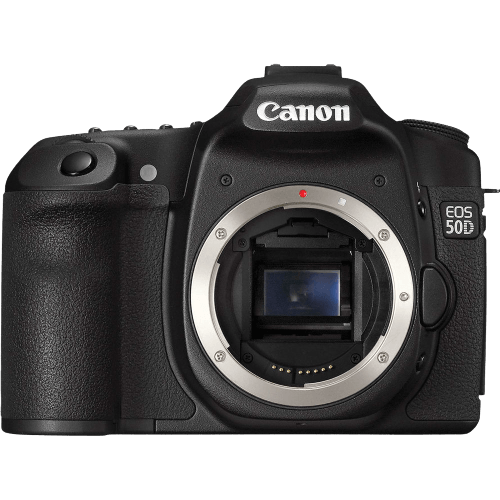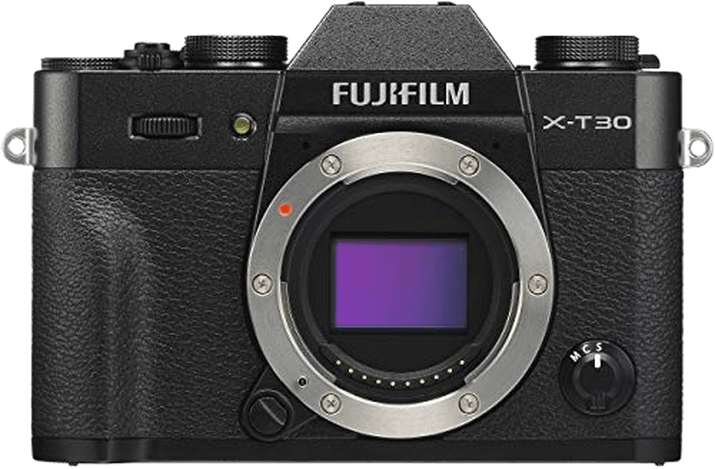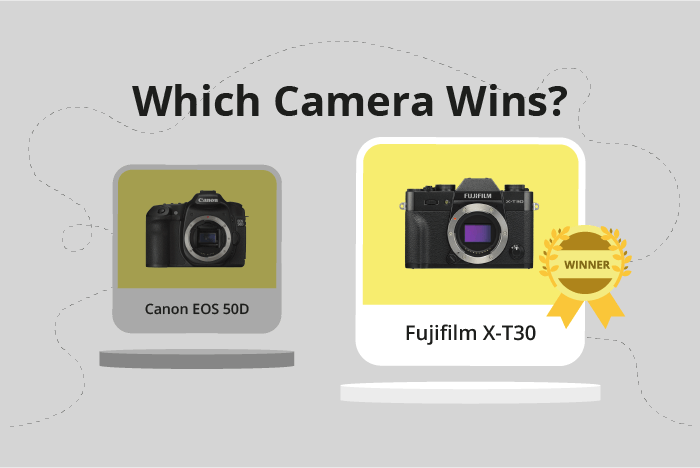Canon EOS 50D vs Fujifilm X-T30 Comparison
Canon EOS 50D

Fujifilm X-T30

The Fujifilm X-T30 outperforms the Canon EOS 50D with a score of 65/100 compared to the latter’s 48/100. Both cameras share similarities in their release years and launch prices, with the Canon EOS 50D being released in 2008 at $1300 and the Fujifilm X-T30 in 2019 at $899.
The Fujifilm X-T30 shows its superiority with its mirrorless design and compact size, measuring 118 x 83 x 47mm and weighing only 383g. This makes it significantly smaller and lighter than the Canon EOS 50D, which has a DSLR design, measures 146 x 108 x 74mm, and weighs 822g.
On the other hand, the Canon EOS 50D may have an advantage in certain situations due to its larger size and weight, providing more stability and a more comfortable grip for some users.
Taking into consideration the scores, design, and size, the Fujifilm X-T30 is the better choice for most users, offering a more compact and lightweight design without compromising on performance. The Canon EOS 50D, while still a viable option, may be better suited for those who prefer a larger camera with a more substantial grip.
Canon EOS 50D vs Fujifilm X-T30 Overview and Optics
The Fujifilm X-T30 is the winner in terms of optics, with a score of 67/100, compared to the Canon EOS 50D’s score of 47/100. Both cameras share some common specifications, such as the APS-C sensor size, CMOS sensor type, and the absence of image stabilization.
The Fujifilm X-T30 is better in several aspects. It has a higher megapixel count of 26, compared to the Canon EOS 50D’s 15.1, providing better image resolution and detail. The X-T30 also boasts a faster shooting speed of 30 frames per second (fps), while the EOS 50D only reaches 6.3 fps. This makes the X-T30 more suitable for capturing fast-moving subjects and action photography. Additionally, the Fujifilm X-T30 features the advanced X-Processor 4, which contributes to its superior performance and image quality.
On the other hand, the Canon EOS 50D has a DXOMARK sensor score of 63. However, it is important to note that DXOMARK does not score Fujifilm cameras, so a direct comparison of sensor scores is not possible in this case. The EOS 50D uses the Canon EF-S lens mount, which allows for compatibility with a wide range of Canon lenses, while the X-T30 uses the Fujifilm X lens mount.
Taking all factors into consideration, the Fujifilm X-T30 is the better choice for photographers seeking higher image resolution, faster shooting speed, and an advanced processor. The Canon EOS 50D may still be a viable option for those who prioritize compatibility with Canon lenses and have no need for the higher specifications offered by the X-T30.
Canon EOS 50D vs Fujifilm X-T30 Video Performance
When it comes to video capabilities, the Canon EOS 50D lacks this feature entirely, as it does not have any video functionality. On the other hand, the Fujifilm X-T30 boasts impressive video capabilities that cater to various needs and preferences.
The Fujifilm X-T30 has a video score of 91 out of 100, which reflects its high-quality video performance. It offers a maximum video resolution of 4K, providing crisp and detailed footage. The camera’s maximum video dimensions are 4096 x 2160, ensuring that users can capture high-definition videos with ease. Furthermore, the X-T30 allows for a maximum video frame rate of 120fps, enabling users to record smooth slow-motion sequences or fast-action scenes without any issues.
Additionally, the Fujifilm X-T30 has built-in time-lapse functionality, which allows photographers and videographers to create stunning time-lapse videos with minimal effort. This feature further enhances the camera’s video capabilities and provides users with more creative options.
Given the lack of video functionality in the Canon EOS 50D, the Fujifilm X-T30 clearly stands out as the better choice for those who require video capabilities in their camera. With its high video score, 4K resolution, and additional features such as time-lapse functionality, the X-T30 offers a comprehensive and versatile video experience for users.
Canon EOS 50D vs Fujifilm X-T30 Features and Benefits
The Fujifilm X-T30 emerges as the winner in this comparison, scoring 70 out of 100 points, while the Canon EOS 50D scores 54 points. Both cameras share some common features, such as a 3-inch screen size and the absence of GPS. However, the Fujifilm X-T30 outshines the Canon EOS 50D in several aspects.
The Fujifilm X-T30 boasts a higher screen resolution of 1,040,000 dots, compared to the Canon EOS 50D’s 920,000 dots. Furthermore, the X-T30 has a touchscreen, which the EOS 50D lacks. The flip screen in the X-T30 adds versatility and convenience for various shooting angles, while the EOS 50D does not offer this feature. The X-T30 also supports WIFI and Bluetooth connectivity, making it easier to transfer files and control the camera remotely, unlike the EOS 50D.
On the other hand, the Canon EOS 50D does not have any distinct advantages over the Fujifilm X-T30 in the features department. The EOS 50D’s lower feature score is due to its lack of modern amenities, such as a touchscreen, flip screen, WIFI, and Bluetooth.
To sum up, the Fujifilm X-T30 is the superior camera in terms of features. Its higher screen resolution, touchscreen, flip screen, WIFI, and Bluetooth capabilities make it a more versatile and user-friendly option compared to the Canon EOS 50D. The EOS 50D falls short in offering competitive features, making it less appealing for those seeking a camera with modern conveniences.
Canon EOS 50D vs Fujifilm X-T30 Storage and Battery
The Canon EOS 50D and Fujifilm X-T30 both score 35/100 in storage and battery. They share similarities, such as having one memory card slot each. The EOS 50D accepts Compact Flash (Type I or II) and UDMA cards, while the X-T30 uses SD, SDHC, and SDXC cards (UHS-I compatible).
The EOS 50D excels in battery life, providing 800 shots per charge with its BP-511A battery. In contrast, the X-T30 offers 380 shots using the NP-W126S battery. This makes the EOS 50D better for extended shooting sessions.
However, the X-T30 gains an advantage with its USB charging capability, allowing for convenient charging options. The EOS 50D lacks this feature.
Considering these factors, the EOS 50D is preferable for longer shooting durations, while the X-T30 offers more flexible charging options. Both cameras have their merits in storage and battery, depending on the user’s priorities.
Alternatives to the Canon EOS 50D and Fujifilm X-T30
Are you still undecided about which camera is right for you? Have a look at these popular comparisons that feature the Canon EOS 50D or the Fujifilm X-T30:

